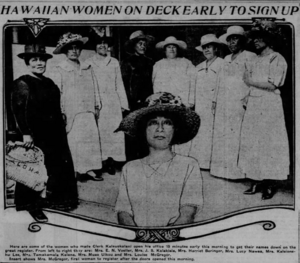Timeline of women's suffrage in Hawaii facts for kids
This is a timeline showing when women in Hawaii gained the right to vote. Hawaii went through many changes. It was first the Kingdom of Hawaii, ruled by a queen. But in 1893, a political takeover removed Queen Liliʻuokalani from power. After this, a new temporary government was set up, and women lost their political power, including the right to vote.
Even with these changes, women like Wilhelmina Kekelaokalaninui Widemann Dowsett and Emma Kaili Metcalf Beckley Nakuina started working to get voting rights for women. When Hawaii became part of the United States, groups like the National American Woman Suffrage Association (NAWSA) also pushed for women's suffrage in the new territory. In 1912, Dowsett and other women formed the National Women's Equal Suffrage Association of Hawai'i (WESAH). Important leaders like Prince Jonah Kūhiō Kalanianaʻole brought petitions to the United States Congress, asking for women's voting rights in 1915 and 1916, but nothing happened right away. In 1919, women from WESAH continued their fight in Hawaii's own legislature, but they didn't succeed then either. Finally, women in Hawaii got the right to vote when the Nineteenth Amendment was added to the U.S. Constitution on August 26, 1920. This amendment gave women across the United States the right to vote.
Contents
The Fight for Votes: Early Days in Hawaii

1890s: A Time of Change
1890
- Two representatives, William Pūnohu White and John Bush, try to change Hawaii's constitution to allow women to vote.
1892
- Joseph Nāwahī also proposes a law to give women the right to vote.
1893
- Queen Liliʻuokalani is removed from power in a takeover. A temporary government is formed.
- Under this new government, women lose many political rights, including the right to vote.
- The Hui Aloha ʻĀina o Na Wahine (Hawaiian Women's Patriotic League) is started on March 27 by Emilie Widemann Macfarlane. This group was formed to oppose the overthrow of the Queen and Hawaii becoming part of the U.S. Later, Abigail Kuaihelani Campbell led the group.
1894
- A special committee from the Women's Christian Temperance Union (WCTU) works to convince delegates at Hawaii's constitutional meeting to support women's voting rights.
1899
- Susan B. Anthony and members of the National American Woman Suffrage Association (NAWSA) write a special request called the "Hawaiian Appeal." They ask the U.S. Congress to give women in Hawaii equal voting rights.
- When Hawaii becomes a U.S. territory, its local legislature loses the power to decide who can vote.
The 20th Century: Gaining the Vote
1910s: Growing Momentum
1912
- Around this time, Emma Kaili Metcalf Beckley Nakuina and Wilhelmina Kekelaokalaninui Widemann Dowsett start organizing groups to support women's voting rights in Hawaii.
- Carrie Chapman Catt, a famous leader in the women's suffrage movement, visits Hawaii.
- The National Women's Equal Suffrage Association of Hawai'i is officially formed.
1915
- Prince Jonah Kūhiō Kalanianaʻole brings a resolution (a formal proposal) about women's voting rights for Hawaii to the United States Congress.
1916
- Prince Kūhiō brings another resolution about women's voting rights to the U.S. Congress.
1917
- Almira Hollander Pitman visits Hawaii and speaks to the local legislature about women's suffrage.
- Prince Kūhiō brings a new bill to the United States Congress. This bill would allow Hawaii to decide its own voting rules.
- June 1: Senator John F. Shafroth presents the suffrage bill in the Senate.
- September 15: The bill successfully passes in the Senate.
1918
- April 29: Maud Wood Park, Anna Howard Shaw, and Pitman speak to the House Committee on Woman Suffrage about voting rights in Hawaii.
- June: The suffrage bill becomes a law! Now, Hawaii's local legislature can make its own decisions about who can vote.
1919
- March 4: A meeting for women's voting rights is held at the Hawaii Capitol.
- March 6: A second meeting for women's suffrage takes place at the Capitol.
- March 19: A demonstration for voting rights is held in Hilo.
- March 23: Large demonstrations happen at the House of Representatives. About 500 women from different backgrounds and ages attend.
1920s: Victory!
1920
- August 26: The Nineteenth Amendment is passed. This amendment applies to all U.S. territories, including Hawaii, giving women the right to vote!
- August 30: The very first voter registration drive for women takes place. Johanna N. Wilcox is the first woman to register to vote in Hawaii.


